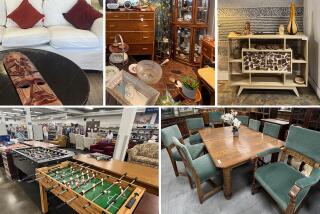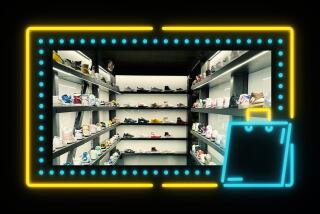Once Overlooked, Nippon Pieces Fetch Thousands
‘Nippon” is a word with several meanings. It is the Japanese name for Japan and was used on pieces exported to the United States from 1891 to 1921. It also is the name of an important Japanese ceramics factory, and the word still appears on porcelain marks.
Most collectors ignored 20th century Japanese porcelains until the 1980s. A vase might have cost only $10 in the ‘70s. Today, the best of the Nippon work sells for thousands of dollars.
A buyer should look at the quality and the decoration to determine what is fair, good or great. Realistic scenes and gold trim add to the desirability.
Pieces marked with a green wreath and an M are made by Noritake. Old examples with the Noritake mark are prized. Modern pieces are less valuable.
*
Question: When were the first teacups made? Where? I collect teacups and saucers and was told that they were used in China in the 18th century. Were they known in England before that?
*
Answer: Porcelain was introduced to Europe from China before 1600. It was a luxury owned only by royalty.
The British East India Trading Co. sailed between the Indies and Europe, and some sailors were permitted to bring back a few pieces of porcelain.
In 1660, Samuel Pepys, an English official whose diary is a record of the times, mentioned that he had a cup of tea for the first time.
Tea was scarce and expensive. Teacups were not made in quantities until the middle of the 18th century. The early teacups often had no handle. Tea was made by pouring hot water on the tea leaves in the cup.
*
Q I’d like some information about my white opaque glass dish in the shape of two fish. On the inside there’s an impressed mark, “Pat. June 4, ’72.”
*
A Your dish is made of milk glass, which was at the height of its popularity during the 1870s. The dish dates from that time, and is known as the dual fish pickle dish. The dish, made by Atterbury & Co. of Pittsburgh, is worth about $85.
*
Q My piece of framed fabric was designed as a pillow cover. What puzzles me is that it pictures a Chinese man sitting on a bench underneath large Chinese words, but at the very bottom of the fabric are the words “Copyright 1902 by R. Behrendt, Esq.” The Chinese words translate as “been in business for 30 years.”
Was my pillow cover made in China or here?
*
A It was made in the United States.
Large pillows with pictures on them were popular in the early 1900s. The design was printed on heavy canvas-like fabric and sold to be put together at home. The copyright date and manufacturer’s name were meant to be hidden in a seam when the pillow was sewn.
R. Behrendt made and sold many of the pillow covers. Most of the covers pictured cupids, attractive women, Indian maids or other romantic subjects.
Oriental designs were popular at the turn of the century.
Covers such as yours sell for $75 to $125.
*
Q I have a pair of Texas steer horns with a 6-foot spread, attached to the intact skull. Should I put a finish on the horns?
*
A You can use any commercial floor wax to polish your steer horns. Then you can buff them with a soft cloth.
Don’t sand the horns or use steel wool on them.
*
Q My mother gave me the desk that I used as a boy in the late 1950s. It is made of maple. There is a leather patch on the front that pictures my then-favorite cowboy hero. It says, “Hopalong Cassidy and Topper.”
Should I try to restore it? I wrote on the top and even carved my initials on the side.
A Part of the charm of a piece of family furniture is the history it represents. The carved initials and the signs of wear add to the value of such pieces of children’s furniture.
You could lightly sand and varnish the desktop, or even wax it. Do not strip off the finish.
Protect the label.
Maple “Hoppy” pieces were made about 1955. Full bedroom sets were available.
Any rustic looking “cowboy” furniture is in demand. Your desk probably is worth $300 without the “Hoppy” label. With it, the desk is worth more than $500.
(BEGIN TEXT OF INFOBOX / INFOGRAPHIC)
Current Prices
Current prices are recorded from antiques shows, flea markets, sales and auctions throughout the United States. Prices vary because of local economic conditions.
* Postcard, black chef cooking Thanksgiving turkey, 1920: $20.
* Hummel figurine, Autumn Harvest, No. 355, V over G: $140.
* Zippo cigarette lighter with World War II battleship Robinson emblem: $30.
* “Elsie’s Magic Recipes” cookbook, 1942: $45.
* Goldscheider figurine, “The Lady Caller,” signed by P. Porcher, 6 1/2 inches: $75.
* World’s Fair plate, Panama Pacific Expo, 1915, San Diego scenes: $110.
* Coca-Cola serving tray, tin, lithograph of lady with large hat holding Coke bottle, “Drink Coca-Cola,” American Art Works, 1938: $145.
* Shirley Temple doll, sleeping flirty eyes, mohair wig, 1930s, Ideal, 24 inches: $205.
* Stanley dealer catalog, No. 110, hard cover, circa 1910, 52 pages: $420.
* Parlor set, mahogany, American, settee, armchair, rocking chair, scrolled arms, triple-arch rails, upholstered cushion, circa 1900: $550.
* Amish patchwork quilt, friendship pattern, cotton, tan with blue baskets, green border, circa 1930, 84 by 81 inches: $625.
* Mount Washington vase, colonial ware, water-jug shape, loop handle, white ground, pink and purple lilies, signed, 13 inches: $1,750.
If you’d like a listing of helpful books and publications on antiques, send a self-addressed, stamped (55 cents) envelope to the Kovels, The Los Angeles Times, King Features Syndicate, 235 E. 45th St., New York, NY 10017.
More to Read
Sign up for The Wild
We’ll help you find the best places to hike, bike and run, as well as the perfect silent spots for meditation and yoga.
You may occasionally receive promotional content from the Los Angeles Times.






